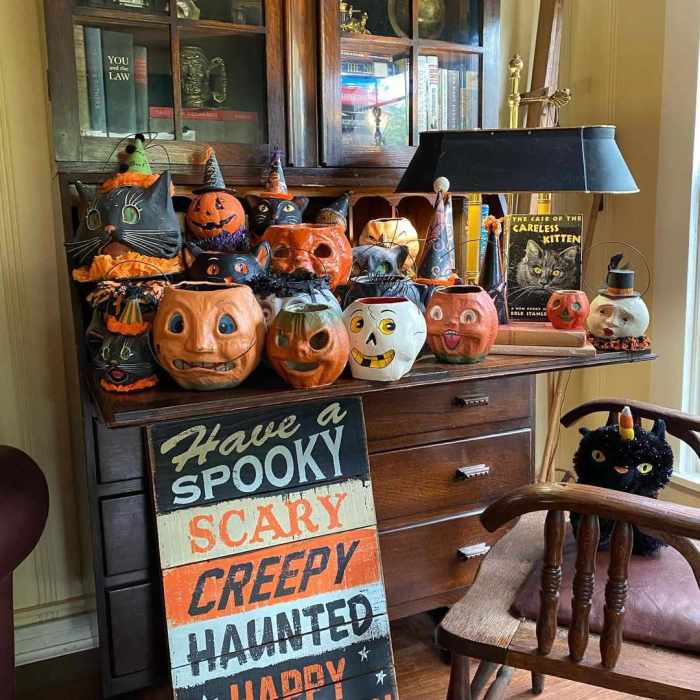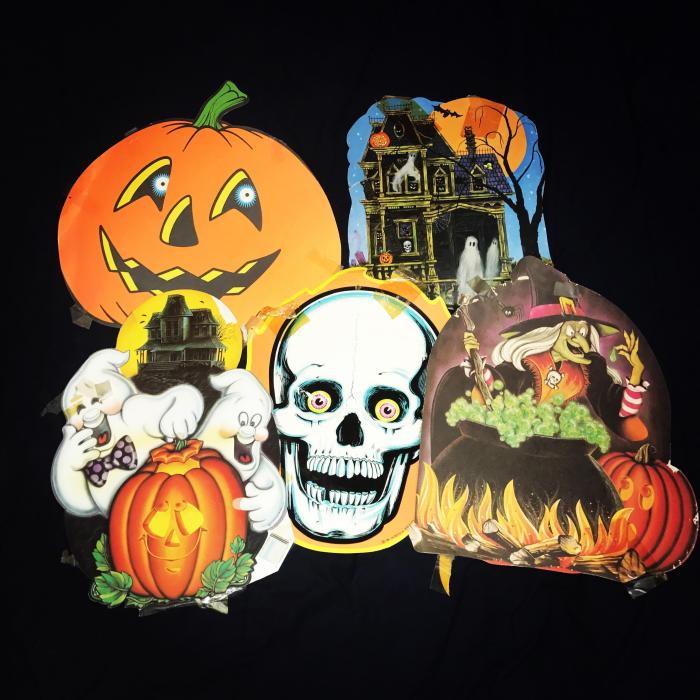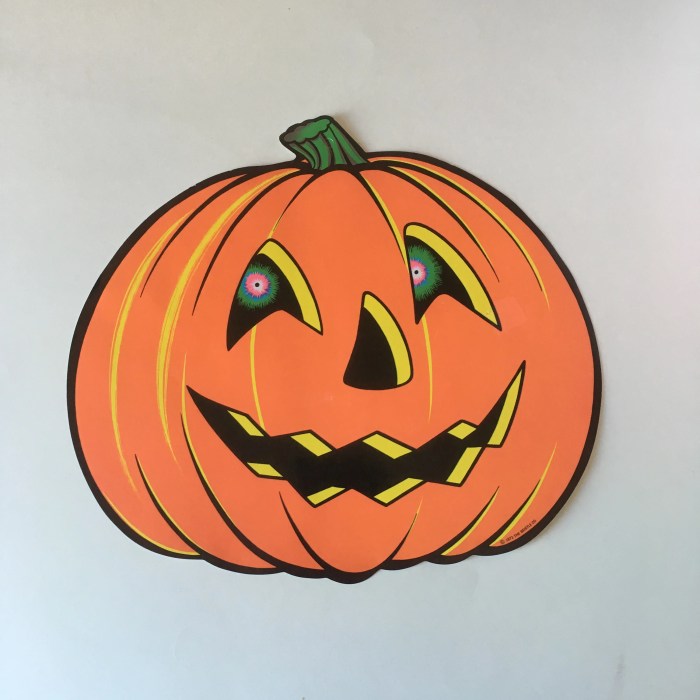Vintage Halloween Decoration: Step back in time and explore the captivating evolution of Halloween décor. From the whimsical charm of early 20th-century designs to the gothic elegance of mid-century pieces, this journey unveils the rich history, craftsmanship, and cultural significance behind these collectible treasures. We’ll delve into popular styles, materials, and themes, tracing their transformation through decades of Halloween celebrations.
Discover the unique characteristics that define vintage Halloween decorations, exploring the materials and manufacturing processes that set them apart from modern counterparts. We’ll examine the enduring themes and motifs, reflecting societal shifts and cultural trends. Learn how to identify, preserve, and even restore these spooky relics, understanding their value and collectibility in today’s market, and how contemporary designers continue to draw inspiration from their timeless appeal.
Defining “Vintage Halloween Decoration”

The term “vintage Halloween decoration” refers to Halloween-themed items produced and used in past decades, now valued for their age, aesthetic appeal, and nostalgic association with bygone eras of Halloween celebrations. These decorations evoke a sense of history and often represent specific stylistic trends prevalent during their time of creation. Their value lies not only in their age but also in their craftsmanship, unique designs, and the cultural context they represent.Defining what constitutes “vintage” in the context of Halloween decorations is somewhat subjective, generally encompassing items from the mid-20th century onward.
However, the most sought-after and valuable pieces often date back to the earlier parts of this period, reflecting evolving tastes and manufacturing techniques. The quality of materials, the artistry involved in their creation, and their overall condition significantly contribute to their perceived vintage status. Furthermore, the rarity of a specific item, its association with popular culture of the time, and its condition all play a role in determining its value and desirability among collectors.
Vintage Halloween Decoration Eras
Several distinct eras contribute to the rich tapestry of vintage Halloween decorations. The mid-20th century, particularly the 1930s through the 1970s, is a significant period. The 1930s and 40s often showcase simpler, more hand-crafted decorations, sometimes reflecting the austerity of the times. The post-war boom of the 1950s and 60s saw a rise in mass-produced decorations, often featuring cartoonish characters and brighter, bolder colors.
The 1970s introduced a more eclectic mix, including spooky and gothic elements that foreshadowed later trends. These variations in style reflect societal shifts and evolving aesthetic preferences.
A Timeline of Vintage Halloween Decoration Styles
The evolution of popular vintage Halloween decoration styles can be broadly categorized across decades, reflecting changing cultural attitudes and technological advancements.
| Era | Style Characteristics | Examples |
|---|---|---|
| 1930s-1940s | Simple, often handmade; focus on traditional symbols like black cats, witches, and pumpkins; muted color palettes. | Paper cutouts, hand-painted cardboard figures, simple fabric ghosts. |
| 1950s-1960s | Mass-produced; brighter colors; cartoonish characters; increased use of plastic and novelty materials; rise of commercially produced costumes and decorations. | Plastic skeletons, inflatable ghosts, cardboard cutouts of popular cartoon characters. |
| 1970s | More diverse styles; incorporation of gothic and spooky themes; use of glitter and metallic materials; emergence of more sophisticated and detailed decorations. | Detailed plastic skeletons, black light posters, glitter pumpkins, haunted house scenes. |
Note that these are broad generalizations, and considerable stylistic variation existed within each era. Regional differences also influenced design and materials used in vintage Halloween decorations.
Vintage Halloween Decoration Themes and Motifs

Vintage Halloween decorations offer a fascinating glimpse into evolving societal attitudes and cultural shifts throughout the 20th century. The themes and motifs employed reflect not only changing aesthetics but also evolving perceptions of fear, death, and the supernatural. Analyzing these decorative choices provides a unique perspective on the historical context of Halloween celebrations.
Evolution of Halloween Themes: Early to Mid-20th Century, Vintage Halloween Decoration
The early to mid-20th century saw a shift in Halloween’s imagery, moving away from purely frightening representations towards a more playful, albeit still slightly spooky, aesthetic. Early Halloween decorations often focused on the macabre, reflecting a time when death and the supernatural were more openly acknowledged aspects of life. However, as the century progressed, a gradual shift towards a more family-friendly celebration occurred.
- Early 1900s – Macabre and Gothic Influences: This era featured imagery strongly influenced by gothic literature and Victorian mourning traditions. Skeletons, ghosts, and grim reapers were common, often depicted in a darkly romantic style. Think stark black and white color schemes, detailed skeletal figures, and a generally somber tone. These decorations reflected a society more comfortable with overt displays of mortality.
- Mid-20th Century – A Rise in Whimsical Imagery: By the mid-20th century, a more playful and whimsical approach emerged. While elements of the macabre remained, they were often softened by cartoonish depictions and brighter color palettes. Black cats, friendly witches, and pumpkins became more prominent, signaling a move towards a more lighthearted celebration, particularly aimed at children. This reflects a post-war societal emphasis on family and childhood innocence.
Late 20th Century Themes: Commercialization and Pop Culture
The latter half of the 20th century saw a significant commercialization of Halloween, leading to a wider range of themes and motifs influenced by popular culture. Mass-produced decorations became more readily available, resulting in a more diverse and often less consistent visual style compared to earlier eras.
- 1950s-1970s – Cartoonish and Campy Aesthetics: This period saw a rise in cartoonish and campy representations of Halloween characters. Witches were often depicted as friendly and mischievous rather than sinister, and black cats were more playful companions than ominous omens. This reflects a growing emphasis on entertainment and a shift away from overtly scary imagery.
- 1980s and Beyond – Horror Movie and Pop Culture Influences: The rise of horror movies and pop culture significantly impacted Halloween decorations. Iconic horror movie characters and monsters became common motifs, reflecting a growing acceptance of more explicit horror themes within the broader celebration. This showcases a societal shift towards a more complex and nuanced engagement with fear and the supernatural.
Preservation and Restoration of Vintage Halloween Decorations

The longevity of vintage Halloween decorations hinges on proper care and preservation. Understanding the materials and construction techniques of these items is crucial for their continued enjoyment and historical significance. Neglect can lead to irreparable damage, diminishing the value and charm of these unique artifacts. This section details effective cleaning, repair, and ethical considerations for preserving your vintage Halloween treasures.
Cleaning Vintage Halloween Decorations
Cleaning vintage Halloween decorations requires a gentle approach to avoid damaging delicate materials. The method employed will depend heavily on the material of the decoration. For example, fragile paper mache requires a different treatment than sturdy metal or plastic. Always test any cleaning method on an inconspicuous area first to ensure it doesn’t cause discoloration or damage.
- Dusting: Begin with a soft brush, such as a feather duster or a soft-bristled artist’s brush, to gently remove loose dust and debris. For intricate details, use compressed air to carefully remove dust from hard-to-reach areas. Avoid harsh blowing, as this can damage delicate pieces.
- Surface Cleaning: For items that can tolerate a slightly damp cloth, use a soft, lint-free cloth lightly dampened with distilled water. Avoid excessive moisture, which can cause warping, mold, or color bleeding. For more stubborn grime, consider using a very mild solution of distilled water and a gentle, pH-neutral soap. Always rinse thoroughly with clean distilled water and allow the item to air dry completely away from direct sunlight or heat.
- Specialized Cleaning: For specific materials like porcelain or glass, consider using specialized cleaning solutions formulated for those materials. Always follow the manufacturer’s instructions carefully. For textiles, such as vintage fabric ghosts or banners, professional cleaning might be necessary to prevent damage.
Repairing Damaged Vintage Halloween Decorations
Repairing damaged vintage Halloween decorations requires patience, precision, and the right materials. The goal is to restore the item to its original condition as much as possible, while maintaining its historical integrity.
- Assessing the Damage: Carefully examine the damage to determine the extent of the repair needed. Note the type of damage (tears, cracks, missing pieces, etc.) and the material involved. This assessment guides the selection of appropriate repair materials and techniques.
- Material Selection: Choose repair materials that are compatible with the original materials. For example, using archival-quality glue for paper mache, or a similarly colored paint for touching up minor scratches on painted items. Avoid using harsh chemicals or modern adhesives that might damage the vintage piece over time.
- Repair Techniques: For minor cracks or tears in paper mache, archival-quality glue and careful patching with matching paper may suffice. For larger repairs, a professional conservator may be necessary. For missing pieces, consider carefully matching materials, perhaps sourcing similar items from antique shops or using historically appropriate reproduction materials. Never use excessive amounts of glue or filler, as this can alter the item’s original appearance and structure.
Ethical Considerations in Restoring Vintage Halloween Decorations
Ethical restoration prioritizes preserving the historical integrity and authenticity of the vintage piece. Avoid overly aggressive restoration methods that may obscure the object’s history or damage its original materials.
Over-restoration, such as repainting an entire item to hide age and wear, removes the object’s patina and diminishes its historical value. Instead, focus on preserving existing features and making repairs that are subtle and reversible, whenever possible. Documenting any repairs made is crucial for maintaining transparency and preserving the object’s provenance.
Using historically accurate materials and techniques ensures that any repairs are consistent with the object’s age and origin. For example, using a paint that matches the original paint formulation, if known, would be preferable to using a modern paint that might alter the item’s appearance over time.
From paper mache pumpkins to intricately carved wooden figures, vintage Halloween decorations offer a tangible connection to the past. Understanding their history, craftsmanship, and cultural significance allows us to appreciate not just their aesthetic value, but also the stories they tell. Whether you’re a seasoned collector or simply appreciate unique and evocative décor, the world of vintage Halloween offers endless fascination and a chance to celebrate the holiday with a touch of timeless charm.